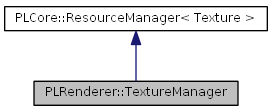This is a manager for the texture resource. More...
#include <TextureManager.h>
Inheritance diagram for PLRenderer::TextureManager:

Public Member Functions | |
| RendererContext & | GetRendererContext () const |
| Returns the owner renderer context of this manager. | |
| float | GetTextureQuality () const |
| Returns the texture quality. | |
| PLRENDERER_API void | SetTextureQuality (float fQuality) |
| Sets the texture quality. | |
| bool | GetTextureFit () const |
| Returns whether the next lower valid texture size should be taken or the higher one. | |
| void | SetTextureFit (bool bLower=true) |
| Sets whether the next lower valid texture size should be taken or the higher one. | |
| bool | AreTextureMipmapsAllowed () const |
| Returns whether or not the usage of texture mipmaps is allowed. | |
| void | SetTextureMipmapsAllowed (bool bAllowed) |
| Sets whether or not the usage of texture mipmaps is allowed. | |
| bool | IsTextureCompressionAllowed () const |
| Returns whether or not the usage of texture compression is allowed. | |
| void | SetTextureCompressionAllowed (bool bAllowed) |
| Sets whether or not the usage of texture compression is allowed. | |
| PLRENDERER_API bool | ReloadTextures () |
| Reloads all textures. | |
| PLRENDERER_API Texture * | CreateTexture (const PLCore::String &sName, TextureBuffer &cTextureBuffer) |
| Creates a new texture. | |
| PLRENDERER_API Texture * | CreateTexture (const PLCore::String &sName, const PLCore::String &sParameters) |
| Creates a texture resource using a texture creator. | |
Static Public Attributes | |
| static PLRENDERER_API const PLCore::String | Default |
Detailed Description
This is a manager for the texture resource.
- Note:
- Unloads unused resources automatically by default
Member Function Documentation
| RendererContext & PLRenderer::TextureManager::GetRendererContext | ( | ) | const [inline] |
Returns the owner renderer context of this manager.
- Returns:
- Reference to the owner renderer context of this manager
| float PLRenderer::TextureManager::GetTextureQuality | ( | ) | const [inline] |
| PLRENDERER_API void PLRenderer::TextureManager::SetTextureQuality | ( | float | fQuality | ) |
Sets the texture quality.
- Parameters:
-
[in] fQuality Texture quality, 1.0 best, 0.0 worst, default is 1.0
- Note:
- Only has an influence on newly loaded textures, not already loaded ones
- If the given texture quality is outside the specified range, it's clamped automatically to the nearest borders
| bool PLRenderer::TextureManager::GetTextureFit | ( | ) | const [inline] |
Returns whether the next lower valid texture size should be taken or the higher one.
- Returns:
- If 'true' the next lower valid texture size will be taken, if 'false' the next higher one is chosen
- Remarks:
- Normally the texture manager will automatically correct invalid texture sizes. With the texture fit setting you can setup whether the next lower or higher valid texture size is selected automatically.
| void PLRenderer::TextureManager::SetTextureFit | ( | bool | bLower = true | ) | [inline] |
Sets whether the next lower valid texture size should be taken or the higher one.
- Parameters:
-
[in] bLower Should the next lower valid texture size be chosen? If 'false' the next higher will be taken
- See also:
- Note:
- Only has an influence on newly loaded textures, not already loaded ones
| bool PLRenderer::TextureManager::AreTextureMipmapsAllowed | ( | ) | const [inline] |
Returns whether or not the usage of texture mipmaps is allowed.
- Returns:
- 'true' if the usage of texture mipmaps is allowed, else 'false'
- See also:
| void PLRenderer::TextureManager::SetTextureMipmapsAllowed | ( | bool | bAllowed | ) | [inline] |
Sets whether or not the usage of texture mipmaps is allowed.
- Parameters:
-
[in] bAllowed 'true' if the usage of texture mipmaps is allowed, else 'false', default is 'true'
- Note:
- Only has an influence on newly loaded textures, not already loaded ones
| bool PLRenderer::TextureManager::IsTextureCompressionAllowed | ( | ) | const [inline] |
Returns whether or not the usage of texture compression is allowed.
- Returns:
- 'true' if the usage of texture compression is allowed, else 'false'
- See also:
| void PLRenderer::TextureManager::SetTextureCompressionAllowed | ( | bool | bAllowed | ) | [inline] |
Sets whether or not the usage of texture compression is allowed.
- Parameters:
-
[in] bAllowed 'true' if the usage of texture compression is allowed, else 'false', default is 'true'
- Note:
- Only has an influence on newly loaded textures, not already loaded ones
| PLRENDERER_API bool PLRenderer::TextureManager::ReloadTextures | ( | ) |
Reloads all textures.
- Returns:
- 'true' if all went fine, else 'false'
| PLRENDERER_API Texture* PLRenderer::TextureManager::CreateTexture | ( | const PLCore::String & | sName, |
| TextureBuffer & | cTextureBuffer | ||
| ) |
Creates a new texture.
- Returns:
- Pointer to the new texture, a null pointer on error
- Remarks:
- A texture wraps up a texture buffer for more comfortable usage within high-level components. In rare situations one texture buffer needs to be referenced by multiple textures - this is what this method is used for. When creating a texture with this method, the given texture buffer is just shared and therefore not automatically destroyed when the texture gets destroyed. If possible, try to avoid using this method because it's somewhat ugly!
| PLRENDERER_API Texture* PLRenderer::TextureManager::CreateTexture | ( | const PLCore::String & | sName, |
| const PLCore::String & | sParameters | ||
| ) |
Creates a texture resource using a texture creator.
- Parameters:
-
[in] sName Texture creator class name (for instance "PLRenderer::TextureCreatorTurbulence3D") [in] sParameters Texture creator parameters. (for instance "XSize='64' YSize='32'") This parameters depend on the used texture creator.
- Returns:
- Pointer to the created resource, a null pointer if there was an error (maybe unknown class or the class is not derived from 'PLRenderer::TextureCreator')
Member Data Documentation
PLRENDERER_API const PLCore::String PLRenderer::TextureManager::Default [static] |
Default texture
The documentation for this class was generated from the following files:

